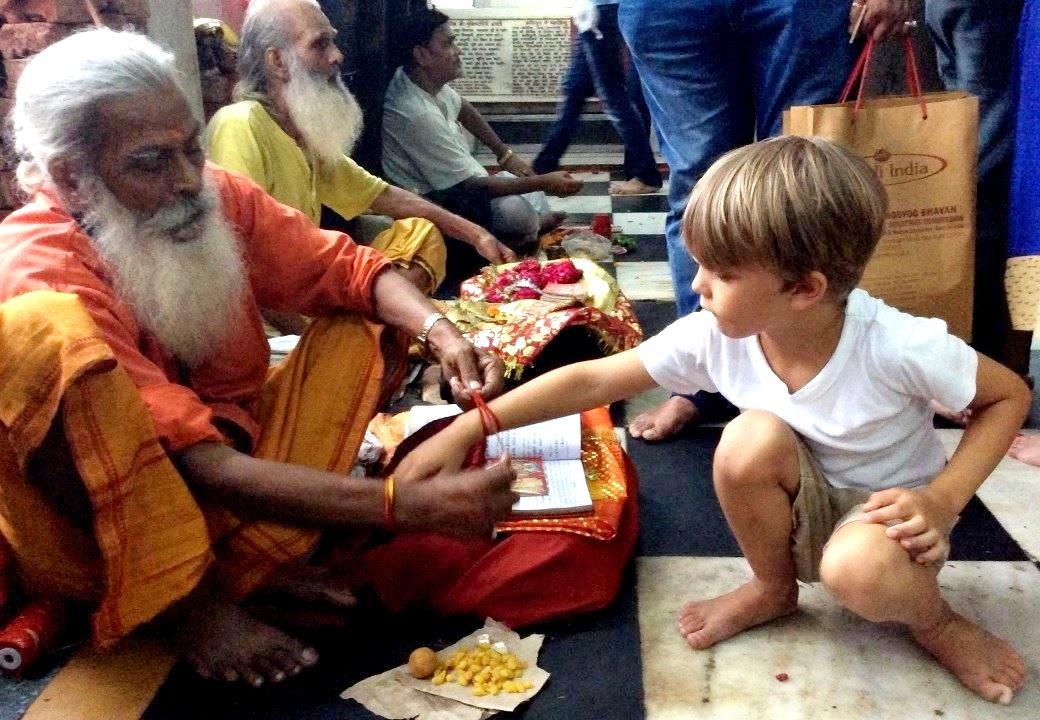
Indian Hinduism: Spreading Religion and Apostacy

Figure 1.--Here a German boy at the Hanuman Temple, Delhi, during an Hindu festivity. The Hindu holy man seems to be giving the boy a wrist band probably part of a blessing. The boy seems fascinated by it. His family was taking an adventursome vacation in India. Unlike Christianity and Islam there is no tradition of missionary activity in Hinuism to convert people. And non-Hindus are welcome in holy places ad festivals.
|
|
Westerners often have trouble understanding Hinduism because it is so very different that Christianity. Two of those differences are attitudes toard speading the faith and apostacy. The spread of the world's four major religions (Buddhism, Christianity, Hinduism, and Islam is a matter of some historical importance. And the process varied and changed over time as the religions were were transmitted across cultures. Missionaries, pilgrims, and converts served as elements of change by facilitating the transmission of diverse beliefs and practices. This was at times done peacefully and at other times by the sword. The missionary impulse has been important to Christianity from the very beginning of the Church, St. Paul being the consumate missionary and a key factor in spread the Gospel by persuasion. Once in command of the Roman state and subsequent medieval states, spreading the Gospel by the power of the state abd then the sword became increasingly important. The missonary impulse remains very important, albeit in a more humanitarian form.. The other two Abrhamic religions (Islam and Judaism) have taken differet approches. Islamic aprroaches to spreading the faith has varies ovrtime. The Jewish approach has been more consistent. There has been little missionary impulse. The same appears to been the case for Hinduism. As a result, with a few exceptions, Hindism has not spread beyond the Asian subcintinent where it developed. Although one reader reports a growing missionary effort among Hindu fundamentalists, this has not been the traditional Hindu way. Although in the last years it grew the Hindu fundamentalism, that is not the traditional way in Hindu religion. There is no tradition of a missionary mission. Hindus do not attempt to convert people to Hinduism. And usually nobody is forbidden to enter holy places and participate to religious rites. They only ask people to respect their rules. One of the most common and strict such rule is to remove any footwear and leave it outside a holy place. It is not allowed carry the shoes in your hands. There were other differences. Apotacy was not permitted in early Christianity and still is not in Islam. The Koran mabdates death to apostates. Hinduim again is different. A Hindu, not a fundamentalist of cours, would probany see conversion to another religion as useless. They see the religions as human ways to go to God. They have no idea of a revelation by God himself. However if a converted would accuse the Hindus to be idolatres or to serve the devil (as sometimes happened) surely that would be seen as a serious insult.
CIH

Navigate the Children in History Website:
[Return to the Main Indian Hindu page]
[Return to the Main Indian religion page]
[About Us]
[Introduction]
[Biographies]
[Chronology]
[Climatology]
[Clothing]
[Disease and Health]
[Economics]
[Freedom]
[Geography]
[History]
[Human Nature]
[Ideology]
[Law]
[Nationalism]
[Presidents]
[Religion]
[Royalty]
[Science]
[Social Class]
[Bibliographies]
[Contributions]
[FAQs]
[Glossaries]
[Images]
[Links]
[Registration]
[Tools]
[Children in History Home]
Navigate the Boys' Historical Clothing national pages:
[Return to the Main countries page]
[Australia]
[Belgium]
[China]
[England]
[France]
[Germany]
[India]
[Indonesia]
[Ireland]
[Italy]
[Japan]
[Korea]
[Malaysia]
[Mexico]
[The Netherlands]
[Portugal]
[Scotland]
[Spain]
[United States]
Created: 2:47 AM 9/2/2017
Last updated: 2:47 AM 9/2/2017



